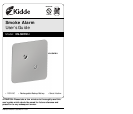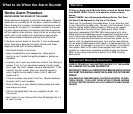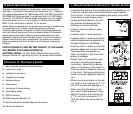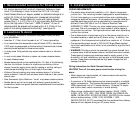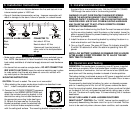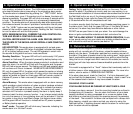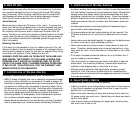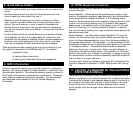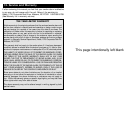
Approximately ten years after the alarm is first powered up it will enter
error mode as indicated by the unit chirping and the red LED flashing
every 30 seconds. When the alarm reaches the end of its useful life it
will discharge its battery so that it can be safely disposed of properly.
When the AC power is removed the unit will be shut off.
Alarm Removal
Before removing, disconnect AC power to the alarm. To remove the
alarm from the mounting bracket rotate it counter-clockwise and gently
pull it down to expose the AC quick connect harness. Simply pull the
two halves of the connector apart to disconnect the alarm from AC
power. The alarm will continue to operate on battery backup for at least
1 week when the battery is fully charged and has not been exposed to
high or low ambient conditions for extended periods through out the
life of the product.
Disabling The Alarm
If the alarm is to be disposed of prior to it reaching its end of life, the
label on the back of the unit should be pierced in the indicated location
and the switch pressed to render the unit safe for disposal. When doing
so the alarm will produce 10 short beeps then shut off.
WARNING: ONCE THE LABEL ON THE BACK OF THE ALARM HAS
BEEN PIERCED, THE INTEGRITY OF THE ALARM HAS BEEN COM-
PROMISED AND IT SHOULD NO LONGER BE USED. DO NOT RE-
INSTALL THE ALARM ONCE IT HAS BEEN DISABLED OR REACHED
IT END OF LIFE. THIS ACTION WILL VOID THE WARRANTY AND
RESOLVE KIDDE OF ANY OBLIGATION.
6. End Of Life 7. Limitations of Smoke Alarms
Ionization sensing alarms may detect invisible fire particles (associated
with fast flaming fires) sooner than photoelectric alarms. Photoelectric
sensing alarms may detect visible fire particles (associated with slow
smoldering fires) sooner than ionization alarms. Home fires develop in
different ways and are often unpredictable. For maximum protection,
Kidde recommends that both Ionization and Photoelectric alarms be
installed.
• A battery powered alarmmust havea battery ofthe specifiedtype, in
good conditionand installed properly.
• AC powered alarms (without battery backup) will not operate if the
AC power has been cut off, such as by an electrical fire or an open
fuse.
• Smoke alarms must be tested regularly to make sure the batteries and
the alarm circuits are in good operating condition.
• Smoke alarms cannot provide an alarm if smoke does not reach the
alarm. Therefore, smoke alarms may not sense fires starting in chim-
neys, walls, on roofs, on the other side of a closed door or on a differ-
ent floor.
• If the alarm is located outside the bedroom or on a different floor, it
may not wake up a sound sleeper.
• The use of alcohol or drugs may also impair one’s ability to hear the
smoke alarm. For maximum protection, a smoke alarm should be
installed in each sleeping area on every level of a home.
• Although smoke alarms can help save lives by providing an early
warning of a fire, they are not a substitute for an insurance policy.
Home owners and renters should have adequate insurance to protect
their lives and property.
7. Limitations of Smoke Alarms
8. Good Safety Habits
WARNING: PLEASE READ CAREFULLY AND THOROUGHLY
• NFPA 72 states: Life safety from fire in residential occupancies is based
primarily on early notification to occupants of the need to escape, fol-
lowed by the appropriate egress actions by those occupants. Fire warn-
ing systems for dwelling units are capable of protecting about half of
the occupants in potentially fatal fires. Victims are often intimate with
the fire, too old or young, or physically or mentally impaired such that
they cannot escape even when warned early enough that escape
should be possible. For these people, other strategies such as protec-
tion-in-place or assisted escape or rescue are necessary.
• Smoke alarms are devices that can provide early warning of possible
fires at a reasonable cost; however, alarms have sensing limitations.
DEVELOP AND PRACTICE A PLAN OF ESCAPE
• Install and maintain a fire extinguisher on every level of the home and
in the kitchen, basement and garage. Know how to use a fire extin-
guisher prior to an emergency.
• Make a floor plan indicating all doors and windows and at least two
(2) escape routes from each room. Second story windows may need a
rope or chain ladder.
• Have a family meeting and discuss your escape plan, showing every-
one what to do in case of fire.



